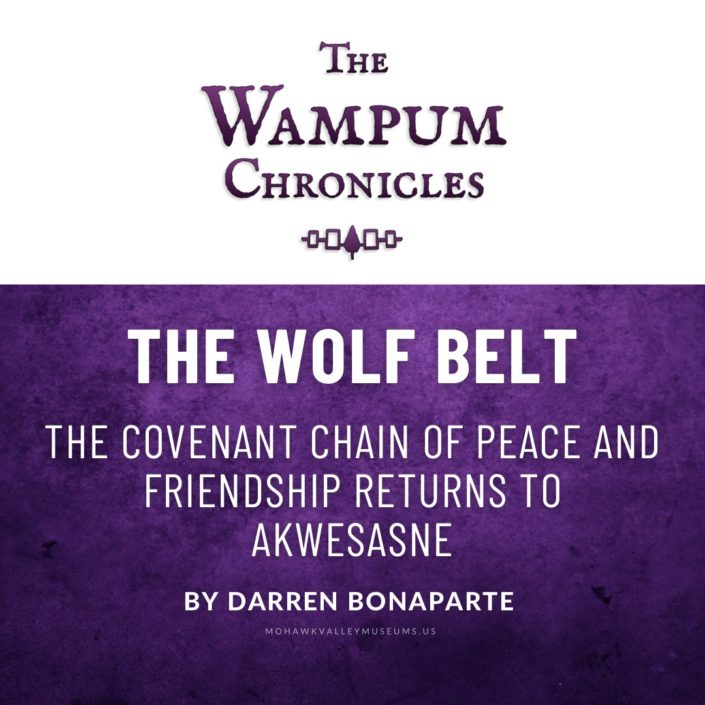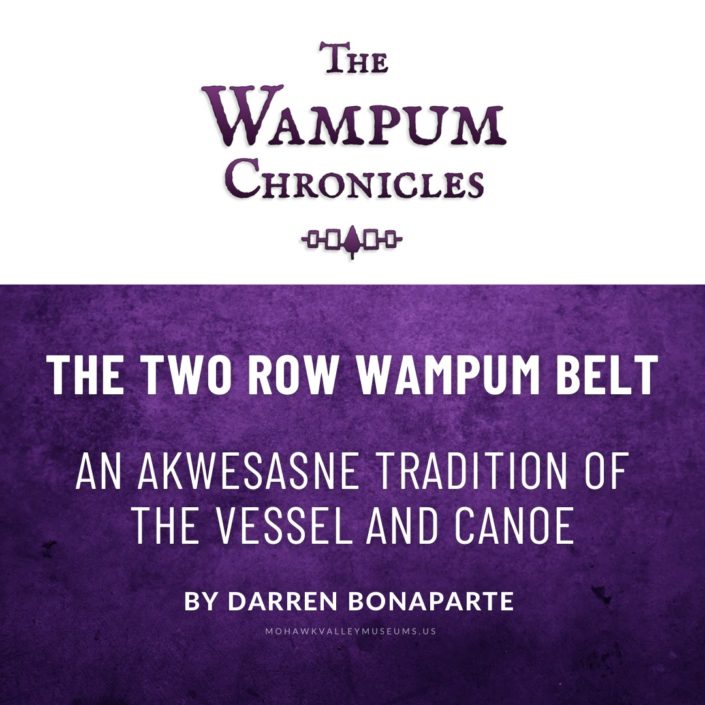
Akwesasne’s First Newspaper and the “Return” to Traditional Government
Written by Darren Bonaparte
Ernest Kaientaronken Benedict, the Akwesasne elder who was honored with the National Aboriginal Achievement Award in 1995, was the founder of not only the North American Indian Travelling College and Akwesasne Notes, but Akwesasne’s first newspaper, Ka-Weh-Ras! (It Thunders) in the late 1940’s. As the editor and reporter, he covered the political turmoil in the community over traditional and elective forms of government, a conflict that had been brewing for generations.
In 1932, Akwesasne traditionalists approached the Grand Council of the Iroquois Confederacy with the goal of being “reinstated” into the workings of the league. In the summer of 1937, Chief George E. Thomas of Onondaga came to speak at a “powwow” held here in Akwesasne. As the Tadodarho of the Six Nations, it was his job to symbolically sweep away the dust from the meeting place, but his presence served to fan the flames of the traditionalism in “The Land Where The Partridge Drums.” This inspired another attempt to abolish the elected government that ruled the St. Regis Mohawk Reservation.
Supporters of traditional government, up to 200 strong, tried to prevent the next scheduled election from being held the following year. This attempt was thwarted by two New York State Troopers who were sent to the polling station to make sure it took place. C. C. Daniels, a representative of the United States Department of Justice, was present as an observer.
In addition to the elected council governing the “American” side of Akwesasne, there was also one on the “Canadian” side, imposed under Canada’s “Indian Act.” There were also the Rotinonkwiseres, or the “Longhairs,” also known as the Life Chiefs. Like the chiefs of the Iroquois Confederacy, they were selected by community clan mothers and appointed for life, but were associated with the Seven Nations of Canada, an alliance of Iroquoian and Algonquian villages established during the days of New France. The Seven Nations alliance faded away over time, and the Life Chiefs had become something of an underground movement with no legal power in the eyes of outside authorities.
The Rotinonkwiseres realized that the time had come for a return to something even more ancient–the Iroquois Confederacy. As Benedict reported in the sixth issue of Ka-Weh-Ras! on December 12, 1947, they put their support behind the traditionalist movement growing Akwesasne:
LIFE CHIEF MEETING
The Life Chiefs of St. Regis met in St. Regis Wednesday, Dec. 10th. They showed great concern over the troubles of their people south of what they term “the white man’s boundary line.”
The chiefs at their meeting made an appeal to the whole reservation to become as one mind, to work as one group in the important days coming. “The only hope for our people lies in the Six Nations Confederacy (and) in the hearts and minds of its people. If we can work as (one, our) united voice will be strong enough to be heard in both Washington and Ottawa. The people should petition their chiefs to clasp hands with their brothers across the border.”
On January 24, 1948, Benedict reported that Kahnawake had gotten involved:
DELEGATES FROM CAUGHNAWAGA
Last weekend, a delegation of five, made up of elected councillors and Six Nations chiefs came from Caughnawaga to see what ways there might be for an even closer cooperation among the Mohawk settlements. They urged a strong union of reservations under a single central government which would be the Mohawk Nation. The delegates were very well received at St. Regis village, but at Hogansburg, the local chiefs took the matter under advisement and are to report their decision on the matter to Caughnawaga soon.
In the May 29, 1948 issue of Ka-Weh-Ras!, Benedict reported that the matter had been brought a vote.
REFERENDUM
Monday, May 24th a referendum was held at the Forrester’s Hall on the subject, What kind of government do you want on the reservation? At a previous council, it was decided to make the selection by ballot. The paper slips gave space to the “Elected Chiefs,” the “Seven Nations Chiefs” and the “Six Nations.”
Eighty-four votes were counted by three men selected in open council at ten o’clock Monday night. Eighty-three fell to the Six Nations. The Elected Chiefs received one vote.
A letter was immediately written by the elected chiefs which follows:
St. Regis Reservation
May 24, 1948To Whom It May Concern,
We, the Undersigned, who are known as the Elected Chiefs of St. Regis Reservation, heretofore operating under the New York State code of Indian Law, hereby act in accordance with the wishes of the adult residents of the St. Regis Reservation, as evidenced by the referendum held on May 24, 1948, and do renounce all claim to authority. Any correspondence hereafter concerning the tribe should be addressed to whomever shall be designated by the Six Nations Chiefs for the purpose. Signed–(by the Elective Chiefs)
The referendum and the letter signed by the elected chiefs had little effect. Outside authorities refused to recognize the “Six Nations” chiefs as the government of the St. Regis Mohawk Reservation. New York State, in fact, mobilized to re-instate the elective system, as the Mohawk Nation Council of Chiefs described in 1982:
On June 7, 1948, the “tribal attorney,” Milton J. Valois, an employee of the State of New York, accompanied by two State Troopers arrived at the Council House to conduct an election. He found the doors to the Council House padlocked and guarded by the clan mothers who refused to permit the elections to be held.
On September 30, 1948, attorney Valois appointed an “elective” government for St. Regis, and on June 13, 1949 conducted an election under State Police guard. The election was held in Hogansburg, one of the former Mohawk lands earlier ceded or leased by the “trustees,” and thus outside the present boundaries of the reservation, in a building donated for the purpose by the missionary, and under an armed police guard.
The elected chiefs who acquiesced to the will of the people were eventually replaced by men who supported the continuation of an elective form of government. In spite of growing traditionalist movement, there were always those who supported elections in Akwesasne on both sides of the border. That situation persists to this day.
Sources:
Kaw-Weh-Ras! Newspaper collection, Museum of the Mohawk People, Akwesasne Library and Cultural Center.
Rethinking Indian Law. National Lawyers Guild Committee on Native American Struggles (CONAS). Advocate Press Inc. New Haven. 1982:160.
Next in series: The Two Row Wampum: An Akwesasne Tradition
By Darren Bonaparte, historian and author of The Wampum Chronicles. Reprinted with permission.
Darren Bonaparte is a cultural historian from the Akwesasne First Nation. He is a frequent lecturer at schools, universities, museums, and historical sites in the United States and Canada. He has written four books, several articles, and the libretto for the McGill Chamber Orchestra’s Aboriginal Visions and Voices. Darren is a former chief of the Mohawk Council of Akwesasne. He is the creator of The Wampum Chronicles and historical advisor to film and television. He currently serves as the Director of the Tribal Historic Preservation Office of the Saint Regis Mohawk Tribe.













 Keppler, Joseph Ferdinand, Artist. Leap-year / J. Keppler. , 1884. N.Y.: Published by Keppler & Schwarzmann. Photograph. https://www.loc.gov/item/2012645186/.
Keppler, Joseph Ferdinand, Artist. Leap-year / J. Keppler. , 1884. N.Y.: Published by Keppler & Schwarzmann. Photograph. https://www.loc.gov/item/2012645186/. Burnetsfield Patent land along the Mohawk River
Burnetsfield Patent land along the Mohawk River